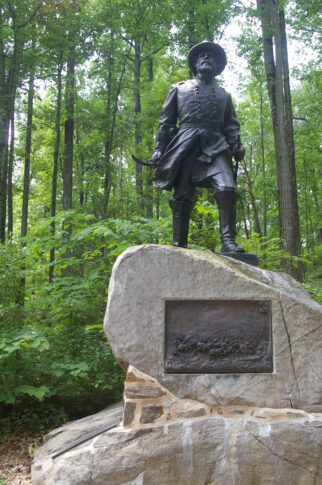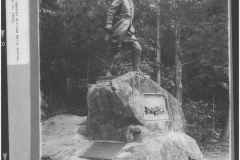Dedicated: May 30, 1914.
Location: South of Confederate Avenue (Section 7), near Plum Run.
Description: Portrait of Major Wells striding forward as he leads the Second Battalion of the 1st Vermont Cavalry across Plum Run in their charge against Law’s Brigade on the afternoon of July 3, 1863. His saber is raised in his proper right hand and his proper left hand rests on the handle of a sword that hangs on his proper left side. The sculpture is installed on a stone boulder adorned with a bronze relief depicting Major Wells’ charge against Law’s Brigade at 5:00 on the afternoon of July 3, 1863. On the far left of the relief, Major Wells can be seen brandishing a saber. On his right, a mortally wounded Brigadier General Elon Farnsworth falls from his horse. Behind Wells, Capt. Henry C. Parson is lying face down on his horse. To the right of Capt. Parsons is F. Stewart Stranahan, First Sergeant Troop L. with his saber raised. Schweizer took care to use several of Wells’ possessions (including his uniform, hat, revolver, boots, and belt) to make the monument more authentic and true to life.
National Park Service List of Classified Monuments Number: MN371.
Sculptor: Schweizer, J. Otto, 1863-1955, sculptor.
Monument Details
About Brevet Major General William Wells

Born December 14, 1837 in Waterbury, Vermont. He was involved in his family’s business at the outbreak of the Civil War and entered service with Company C of the 1st Vermont Cavalry.
During the ill-fated assault known as Farnsworth’s Charge late on July 3, Wells led a battalion of the 1st Vermont. He was awarded the Medal of Honor for this action; the citation reads, “Led the second battalion of his regiment in a daring charge.” He finished the War as a brevet major general, having thus received more promotions than any other Vermont officer during the war (from Private to General in less than three and a half years). Sheridan called Wells, “my ideal of a cavalry officer.” In all, he participated in seventy cavalry engagements.
After the War, Wells was a state senator in Vermont. He was a member of the Gettysburg Commission in 1889-90. He was president of several Burlington corporations as well. Wells died suddenly of heart disease at the age of 54 on April 29, 1892. Burlington effectively shut down for his funeral; he is honored by a copy of the same statue which stands at Gettysburg in that city.











